|
Democratic supervision mechanism has been continuously enhanced. A nationwide information network for poverty alleviation has been set up and each poor household and poor village has been identified and registered through a process of application, appraisal, announcement to the public, and level-by-level approval, to ensure the public's right to know and to participate. The state has applied democratic and scientific decision making, given full respect to the development interests of people in need, and invited them to participate in decision-making concerning poverty alleviation, and the implementation, management and supervision of programs. The government publicizes funding arrangements and program updates to ensure transparent operation and institutionalize access to information as a regular practice. The state has entrusted relevant scientific institutions, social organizations and other independent third parties to assess the accuracy of processes to identify and to deregister the poor population, to measure the satisfaction of those receiving assistance tailored to the conditions of their own household or village, and other indexes. Other political parties have been encouraged to exercise supervision over poverty alleviation work. The central committees of China's eight non-CPC parties have been paired up with the eight poorest provinces and equivalent units in central and western China, their main role being to supervise the activities for identifying the poor, and lifting them out of poverty. The state has strengthened supervision over disciplined execution and auditing in poverty alleviation, and launched a special campaign to prevent and address abuses of power in this field. The government has improved the information disclosure mechanism, and set up the hotline "12317" to allow the reporting of misconduct in poverty alleviation work, giving full play to the role of the public in supervision. VI. Poverty Reduction at a Crucial Stage The remarkable achievements of China's poverty reduction strategy will figure prominently in the history of mankind's fight against poverty. However, the Chinese government is fully aware that the fight remains tough as the country still has a large population living in profound poverty, and the solutions to their problems are becoming increasingly costly and complex. Faced with these major problems, China has entered the crucial stage of poverty reduction - this will prove a hard nut to crack. Most of the targets of China's poverty reduction efforts are now those living in extreme poverty, and this poses formidable problems for the country. The first issue is the scale of the problem. By the end of 2015, there were still 14 contiguous poor areas with special difficulties, 832 impoverished counties, 128,000 registered poor villages, and 55.75 million people living in poverty - this is the equivalent of the entire population of a medium-sized country. The second problem is the nature of the challenge - the increasing cost and complexity resulting from the extreme degree of poverty afflicting the majority of these people, and their weak capacity for development. The third is time pressure - China has set itself the goal of lifting 10 million people out of poverty every year from 2016. The fourth is the high risk of a return to poverty - a large number of poor households struggle to remain free of poverty, and can be pushed back into poverty as a result of factors such as natural disaster, illness, or issues involving education, marriage and housing; they therefore rejoin the existing impoverished population. Chart: Rural population lifted out of poverty from 2011 to 2015 totaling 109.92 million
Graphics shows that rural population lifted out of poverty from 2011 to 2015 totaling 109.92 million, Oct. 17, 2016. (Xinhua/Zhou Daqing) |
- Home
- News |Tibet |Exclusive |China |World |Related News |Latest
- Documents |White Papers |Others
- Photo |Politics |Economy & Society |Culture & Religion |Human & Nature |Beautiful Tibet |Other Tibetan-Inhabited Area |Exchanges |Related
- Video |News |Documentary |Micro-Video |Entertainment
- Art
- Tourism
- In Focus
- About Tibet







